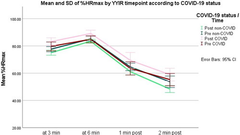ABSTRACT
Aims
This study aimed to explore the epidemiological circumstances, long-term clinical outcomes, and perceived impact of severe acute respiratory syndrome coronavirus 2 (SARS-CoV-2) infection on elite athletes’ sports performance. A secondary objective was to determine the sports-specific (contact vs. noncontact) prevalence of SARS-CoV‑2 among 65 SARS-CoV-2-positive athletes from the Olympic Training Center Rhineland (OSP; n = 599).
Methods
In all, 65 SARS-CoV-2-positive athletes from the German Olympic Training Center (OSP; 66% males—age: 23 ± 4 years; 34% females—age: 23 ± 5 years) participated in the panel study. Data collection occurred between June 2020 and October 2021 at two test times (t0: after a negative polymerase chain reaction [PCR] test, t1: 16 weeks after t0) through questionnaires and clinical assessments.
Results
The SARS-CoV‑2 prevalence was nearly identical in noncontact and contact-sport athletes (10.8% vs. 11.3%); 37% experienced symptoms lasting > 4 weeks. Over 50% of athletes paused their training for 4–8 weeks. At t1, 40% still experienced reduced perceived performance capacity (PPC) compared to their pre-COVID-19 level, while 64% reported ongoing limitations in sports participation, with mental and physical fatigue as the most prominent limiting factor, followed by shortness of breath and joint and muscle pain.
Conclusion
The long-term management of SARS-CoV-2-positive elite athletes should involve a comprehensive, multidimensional psychophysiological approach to address persistent sport-restricting symptoms. This approach will assist in developing tailored training protocols that allow a gradual increase in intensity and volume.
